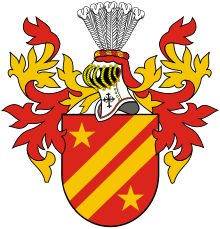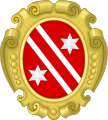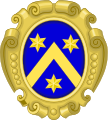Giuseppe Maria Buonaparte
Giuseppe Maria Buonaparte (born May 31, 1713 in Ajaccio ; † December 13, 1763 there ) was a Corsican politician and grandfather of the French Emperor Napoleon I.
Life
In 1749 he became representative of the city of Ajaccio in the Corsican Council of Corte . In 1741 he married in Ajaccio Maria Saveria Paravisini, whose parents were Genoese nobles. He had four children with her, Maria Gertrude Buonaparte, Sebastiano Buonaparte, Carlo Buonaparte and Marianna Buonaparte, who died early. After Maria died, Giuseppe Maria married Virginia Alata . The marriage remained childless.
Ancestors in Corsica
Giuseppe Maria was the son of Sebastiano Nicola Buonaparte and Maria Anna Tusoli. Sebastiano Nicola was a member of the council of the city of Ajaccio since April 20, 1720. Maria Anna Tusoli (1690–1760) came from Boccognano and belonged to the minor nobility.
Sebastiano Nicola was the son of the captain (capitano) of the council of Ajaccio Giuseppe Maria Buonaparte (1663–1703) and Maria Colonna di Bozzi (approx. 1668–1704).
Giuseppe Maria's parents were Carlo Maria Buonaparte (1637-1692), from 1666 until his death captain of the council of Ajaccio and Virginia Odone (daughter of the merchant Pietro Odone and the noblewoman Costanza Pozzo di Borgo).
Carlo Maria's parents were Sebastiano Buonaparte (1603 - 1642/1643), captain of the city council from 1620 and cancelliere in Ajaccio from 1633 , and Maria Rastelli.
Sebastiano's parents were Francesco Buonaparte (approx. 1570 - 1633) and Camilla Catacciolo. Francesco was a soldier in the service of the Republic of Genoa and became the commanding colonel of the Corsica regiment.
Francesco was the son of Geronimo Buonaparte (approx. 1550 - 1650) and Pellegrina Calvari. Geronimo was around 100 years old and has served on Ajaccio's council and senate for most of his life, since 1594 as captain of the city council.
Geronimo was the son of Gabriele Buonaparte († 1589), who was married to a daughter of Francesco Montano, a Corsican patrician.
Gabriele was a son of Francesco Buonaparte († 1540), called "the Moor" (il Moro) , and the Caterina da Castelletto.
Francesco was a patrician from Sarzana in Liguria and served as a cavalry mercenary in the sea trading fleet of the Banco di San Giorgio . In 1490 he came to Corsica and in 1493 married the daughter of Guido da Castelletto, representative of the Bank San Giorgio in Corsica. Shortly after 1500, Francesco left the bank.
| Giuseppe Maria Buonaparte Senior (1663–1703) | ||||||||||||||||
| Sebastiano Nicola Buonaparte (1683-1720 / 1760) | ||||||||||||||||
| Maria Colonna Bozzi (1668–1704) | ||||||||||||||||
| Giuseppe Maria Buonaparte (1713–1763) | ||||||||||||||||
| Carlo Tusoli | ||||||||||||||||
| Maria-Anna Tusoli (1690-1760) | ||||||||||||||||
| Isabella N. | ||||||||||||||||
Origin from Sarzana
The Buonaparte were originally a patrician family from Sarzana in Liguria , where they first appear with Gianfaldo Buonaparte around 1200. The notary Giovanni Buonaparte married Isabella Calandrini in 1397, cousin of the later Cardinal Filippo Calandrini , was mayor of Sarzana and in 1408 Giovanni Maria Visconti appointed commissioner of the Lunigiana . It was his great-grandson Francesco who went to Corsica in 1490.
Ancestry legend in the 19th century
A Florentine archivist named Passerini, head of the Biblioteca Magliabechiana (now part of the Biblioteca Nazionale Centrale di Firenze ) claimed in 1856 that during the reign of Emperor Napoleon III. that he had found in the State Archives of Florence a document dated May 15, 1235, according to which a Jamfaldus from Florence had made a donation to the Ospedale di Rosaia (Hospital of Rosaia); it mentions a "Willielmo qui nuncupatur Bonaparte" as the son of Jamfaldus and mentions the great Count Ugo as the founder of the hospital, a representative of the famous Cadolingi family who appeared between 923 and 1113, namely as the "ancestor (abavus) of Jamfaldus".
Hansmartin Schwarzmaier (in: Dizionario Biografico degli Italiani, vol. 16, 1973 ) explains: “We do not know whether this Passerini, who directed the Biblioteca Magliabechiana in Florence and had a long experience in the study of manuscripts, is not yet was aware that the document of 1235 was a gross modern forgery, or whether, against all evidence, he wanted to adhere to it in order to pay homage to the French emperor through his work. In any case, his genealogical construction does not stand up to critical scrutiny and research on events relating to the Cadolingi family must be limited to the two centuries between 923 and 1113 during which they were one of the most powerful families in Tuscany. "
However, a Buonaparte family actually existed in Florence, which died out in 1803 with Abbot Gregorio Buonaparte. He left his estate to the then General Napoleon Bonaparte, who donated it to a non-profit organization in Florence. There was also a Buonaparte family in San Miniato , which had a coat of arms similar to that of the Buonaparte from Sarzana (red and silver instead of red and gold emblazoned and mirrored). The Buonaparte from San Miniato went out around 1550 with Jacopo Buonaparte . The burial place of the branch from San Miniato is in the Franciscan church there. For the branch from Ajaccio, Napoleon III. Build the Chapelle Impériale there in 1857 .
See also
Web links
- List of descendants of Francesco Buonaparte (English)
| personal data | |
|---|---|
| SURNAME | Buonaparte, Giuseppe Maria |
| BRIEF DESCRIPTION | Corsican politician and grandfather of the French Emperor Napoleon I. |
| DATE OF BIRTH | May 31, 1713 |
| PLACE OF BIRTH | Ajaccio |
| DATE OF DEATH | December 13, 1763 |
| Place of death | Ajaccio |




